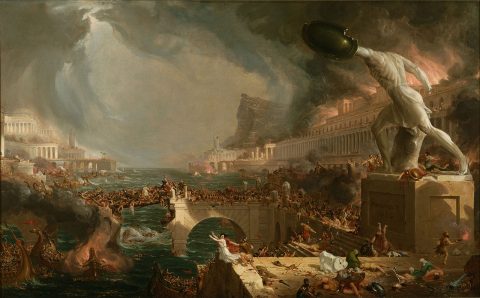David Friedman happened upon an article he wrote 45 years ago on the works of J.R.R. Tolkien:
The success of J.R.R. Tolkien is a puzzle, for it is difficult to imagine a less contemporary writer. He was a Catholic, a conservative, and a scholar in a field-philology-that many of his readers had never heard of. The Lord of the Rings fitted no familiar category; its success virtually created the field of “adult fantasy”. Yet it sold millions of copies and there are tens, perhaps hundreds, of thousands of readers who find Middle Earth a more important part of their internal landscape than any other creation of human art, who know the pages of The Lord of the Rings the way some Christians know the Bible.
Humphrey Carpenter’s recent Tolkien: A Biography, published by Houghton Mifflin, is a careful study of Tolkien’s life, including such parts of his internal life as are accessible to the biographer. His admirers will find it well worth reading. We learn details, for instance, of Tolkien’s intense, even sensual love for language; by the time he entered Oxford, he knew not only French, German, Latin, and Greek, but Anglo-Saxon, Gothic and Old Norse. He began inventing languages for the sheer pleasure of it and when he found that a language requires a history and a people to speak it he began inventing them too. The language was Quenya, the people were the elves. And we learn, too, some of the sources of his intense pessimism, of his feeling that the struggle against evil is desperate and almost hopeless and all victories at best temporary.
Carpenter makes no attempt to explain his subject’s popularity but he provides a few clues, the most interesting of which is Tolkien’s statement of regret that the English had no mythology of their own and that at one time he had hoped to create one for them, a sort of English Kalevala. That attempt became The Silmarillion, which was finally published three years after the author’s death; its enormous sales confirm Tolkien’s continuing popularity. One of the offshoots of The Silmarillion was The Lord of the Rings.
What is the hunger that Tolkien satisfies? George Orwell described the loss of religious belief as the amputation of the soul and suggested that the operation, while necessary, had turned out to be more than a simple surgical job. That comes close to the point, yet the hunger is not precisely for religion, although it is for something religion can provide. It is the hunger for a moral universe, a universe where, whether or not God exists, whether or not good triumphs over evil, good and evil are categories that make sense, that mean something. To the fundamental moral question “why should I do (or not do) something”, two sorts of answers can be given. One answer is “the reason you feel you should do this thing is because your society has trained you (or your genes compel you) to feel that way”. But that answers the wrong question. I do not want to know why I feel that I should do something; I want to know why (and whether) I should do it. Without an answer to that second question all action is meaningless. The intellectual synthesis in which most of us have been reared — liberalism, humanism, whatever one may call it — answers only the first question. It may perhaps give the right answer but it is the wrong question.
The Lord Of The Rings is a work of art, not a philosophical treatise; it offers, not a moral argument, but a world in which good and evil have a place, a world whose pattern affirms the existence of answers to that second question, answers that readers, like the inhabitants of that world, understand and accept. It satisfies the hunger for a moral pattern so successfully that the created world seems to many more real, more right, than the world about them.
Does this mean, as Tolkien’s detractors have often said, that everything in his books is black and white? If so, then a great deal of literature, including all of Shakespeare, is black and white. Nobody in Hamlet doubts that poisoning your brother in order to steal his wife and throne is bad, not merely imprudent or antisocial. But the existence of black and white does not deny the existence of intermediate shades; gray can be created only if black and white exist to be mixed. Good and evil exist in Tolkien’s work but his characters are no more purely good or purely evil than are Shakespeare’s.







